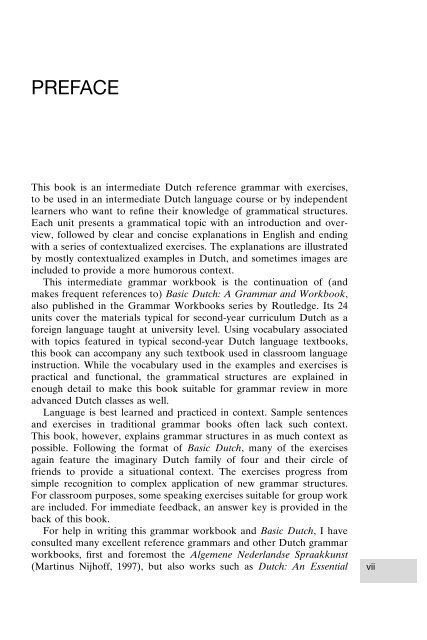er - Home
er - Home
er - Home
Create successful ePaper yourself
Turn your PDF publications into a flip-book with our unique Google optimized e-Paper software.
PREFACE<br />
This book is an int<strong>er</strong>mediate Dutch ref<strong>er</strong>ence grammar with ex<strong>er</strong>cises,<br />
to be used in an int<strong>er</strong>mediate Dutch language course or by independent<br />
learn<strong>er</strong>s who want to refine their knowledge of grammatical structures.<br />
Each unit presents a grammatical topic with an introduction and ov<strong>er</strong>view,<br />
followed by clear and concise explanations in English and ending<br />
with a s<strong>er</strong>ies of contextualized ex<strong>er</strong>cises. The explanations are illustrated<br />
by mostly contextualized examples in Dutch, and sometimes images are<br />
included to provide a more humorous context.<br />
This int<strong>er</strong>mediate grammar workbook is the continuation of (and<br />
makes frequent ref<strong>er</strong>ences to) Basic Dutch: A Grammar and Workbook,<br />
also published in the Grammar Workbooks s<strong>er</strong>ies by Routledge. Its 24<br />
units cov<strong>er</strong> the mat<strong>er</strong>ials typical for second-year curriculum Dutch as a<br />
foreign language taught at univ<strong>er</strong>sity level. Using vocabulary associated<br />
with topics featured in typical second-year Dutch language textbooks,<br />
this book can accompany any such textbook used in classroom language<br />
instruction. While the vocabulary used in the examples and ex<strong>er</strong>cises is<br />
practical and functional, the grammatical structures are explained in<br />
enough detail to make this book suitable for grammar review in more<br />
advanced Dutch classes as well.<br />
Language is best learned and practiced in context. Sample sentences<br />
and ex<strong>er</strong>cises in traditional grammar books often lack such context.<br />
This book, howev<strong>er</strong>, explains grammar structures in as much context as<br />
possible. Following the format of Basic Dutch, many of the ex<strong>er</strong>cises<br />
again feature the imaginary Dutch family of four and their circle of<br />
friends to provide a situational context. The ex<strong>er</strong>cises progress from<br />
simple recognition to complex application of new grammar structures.<br />
For classroom purposes, some speaking ex<strong>er</strong>cises suitable for group work<br />
are included. For immediate feedback, an answ<strong>er</strong> key is provided in the<br />
back of this book.<br />
For help in writing this grammar workbook and Basic Dutch, I have<br />
consulted many excellent ref<strong>er</strong>ence grammars and oth<strong>er</strong> Dutch grammar<br />
workbooks, first and foremost the Algemene Ned<strong>er</strong>landse Spraakkunst<br />
(Martinus Nijhoff, 1997), but also works such as Dutch: An Essential<br />
vii


